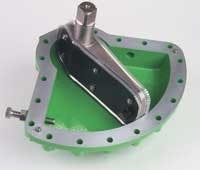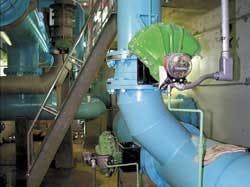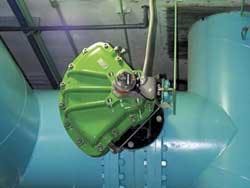New valve actuator option strengthens filtering control
By Dave Rizzo
Pneumatic rotary actuator
Rotary-action, pneumatic technology provides a simple, reliable alternative to controlling valves that helps water works engineers to better control turbidity levels while reducing downtime and premature backwashes.
Under pressure from regulatory mandates, water works engineers and plant managers must scrutinise all elements of their potable water treatment operations, and none is more important than filtering. Water leaving this point must fall within mandated turbidity levels of 0.3 NTU (Nephelo-metric Turbidity Unit) or less in the USA, as mandated by the US Safe Drinking Water Act. Over the past decade, much attention has been directed at plant control systems in the USA to achieve these levels.
Water works engineers are now turning to a new generation of pneumatic valve actuators that can execute the instructions of electronic control systems with the necessary precision to accurately control effluent flow. This new breed of actuators is also meeting the need to reduce downtime, as some of the first ones to debut in 1981 are still in operation without needing a spare (new) part. A cost-savings factor of up to 40% when compared to electric actuators also helps to explain the widening acceptance of these new pneumatic actuators by plant engineers and managers faced with the responsibility of delivering potable water at a cost-effective rate. The "fail safe" (fail-closed or fail-open) feature of pneumatic actuators protects the plant during a temporary or extended power outage.
Simple design of pneumatic rotary vane actuators allow in-the-field repair.
Since filtration is typically the final step (before storage) in most water treatment operations, any water leaving the filtration process should be well within turbidity limits. Hence, any efficiency gains in filter operation will help plant operators to not only meet federal clean water requirements, but also help reduce plant-operating costs.
Plant managers know that a delicate balance must be struck by maintaining the design flow rate of the filter. The operator must use good judgement in establishing operational goals and exercising process control to achieve optimal finished water quality production.
Recommended process controls are already in place with the introduction of modern plant PLC (programmable logic controllers) and SCADA (supervisory control and data acquisition) systems. Despite these gains, archaic valve actuation remains the weakest link in filtering operations.
"There are only certain ways you can achieve a lower turbidity, and the one that is important is accurate valve control," said Fred Underwood, president of K-TORK, a US manufacturer of high-performance rotary actuators based in Dallas, Texas. "Valves with actuators receiving commands from the filter control system to properly execute the backwash option are pivotal in the process. If the effluent valve does not shut off, the backwash water containing the solids removed by the filter media will flow into the clear well and the measured turbidity levels will exceed the mandates. You have to have actuators that operate the valves precisely closed. There's no point in having the best PLC system if the actuators it controls aren't executing those instructions accurately and reliably."
Since mixed-media filter performance is affected significantly by hydraulic characteristics, accurate valve control begins at the point of bed loading. Typical loading rates range from two to eight gallons per minute (gpm) per square foot of filter bed surface area. The effluent valve must carefully meter these rates because as the filter bed becomes dirty and clogged with solids, the resistance to flow rises.
"When the filter media is fresh and clean it will pass more water than the specified design GPM, so you must close the effluent valve to the point where it only allows the flow rate that the filter media is designed to pass at that time," Underwood explained. "Turbidity-meter, or headloss DP instrumentation tracks the levels and determines the most appropriate time to trigger a backwash. Accurate valve actuation allows the PLC or SCADA system to maintain the correct flow rate until such time."
As the media gets dirty near the end of the filter run and the filter becomes clogged, the effluent valve needs to open more. Ultimately flow will cease when the resistance to flow is greater than the gravitational force compelling it. As the "head" (hydraulic pressure) increases, solids particles are pushed further and further into the media bed. Solids will be driven completely through the bed and appear in the filtered water.
Compact vane actuators can fit into tight spaces
Turbidity levels will increase and the filter controls will shut down the process.
"High turbidity levels are prevented by performing a backwash, but it is an expensive and time consuming process so you really don't want to backwash until you have to," noted Underwood. "That filter is out of commission during the backwash process, and you're having to do it with clean potable water that you just spent money cleaning. So the key to operational efficiency is to keep the flow at exactly the right levels and backwash when necessary determined by the filter control system and carried out by the actuators."
Many older plants are currently involved in plant improvements and controls upgrading because valve control accuracy and reliability play such an important role throughout all filtering operations and in meeting federally mandated turbidity levels. The original pipe galleries and valves will remain in place in most instances; however a new control system is usually the first step to be implemented. This changeover immediately requires new actuators that interface with modern control systems. Yet, until recently, electric actuators were the primary actuators that came equipped to interface with the first electronic control systems.
Pneumatic rotary actuators
Although rotary actuators were first introduced to the USA from Europe in the early 1970s, the most recent rotary actuator designs meet American Water Works Association standards and provide a new option for new facilities and plant upgrades.
The K-TORK actuator design uses only one moving part. By scribing an arc, all torque forces directed to the valve remain constant from fully open to fully closed. Absent the need to convert linear motion to rotary, "pinch points" are avoided. Given a smaller torque-to-size ratio, compact vane actuators can fit into the tight quarters of filter galleries and still exert a tremendous amount of force on 1/4-turn valves, for instance.
The vane design also ensures accurate control and no hysteresis. Because no O-ring seals are needed, vane actuators can provide years of service in demanding, high-cycle, fast-operation and critical modulating applications; thus allowing water treatment engineers to carefully control turbidity levels.
K-TORK designs vane actuators in a "default" setting to protect treated water in the event that a power grid goes out. The actuator can be set to a plant operator's specification as to whether the valve should be held in the open or closed position. The rotary vane of the actuator then automatically holds that position until power is restored, which prevents flooding of filter galleries.
The simple structure of pneumatic rotary-vane actuators allows "in-the-field" repair. "In a smaller water treatment facility, say in a town of about 10,000, the city engineer and his staff may wear several different hats," noted Underwood. "One day they might be doing road repairs, and the next day working in the water plant. But a pneumatic actuator with one moving part is simple to work on. If the guy can use a screwdriver or a wrench, he can pretty much understand how to fix a K-TORK vane actuator."
Facility engineers are installing rotary actuators in water works plants with increasing frequency due to their lower cost and easy installation. Some vane actuator designs come ready equipped for mounting into existing plants. "One problem is that valve manufacturers don't necessarily make the mounting hardware for retrofit," observed Underwood. "That leaves a facility engineer or a supplier with the responsibility of sketching something out on a piece of paper and taking it to a local machine shop.
For challenging retrofits, some rotary-actuator manufacturers send their experts out into the field to help facilitate the installation process. Vane actuators are allowing water works management to increase water production while decreasing maintenance costs. Whether private or municipal, these kinds of operational efficiencies can be taken straight to the bank.
Author's note
Based in Fullerton, California, USA, David Rizzo, D.P.M has researched and written numerous articles on water industry issues. For more information contact K-TORK at Email: [email protected]; or visit www.ktork.com.





